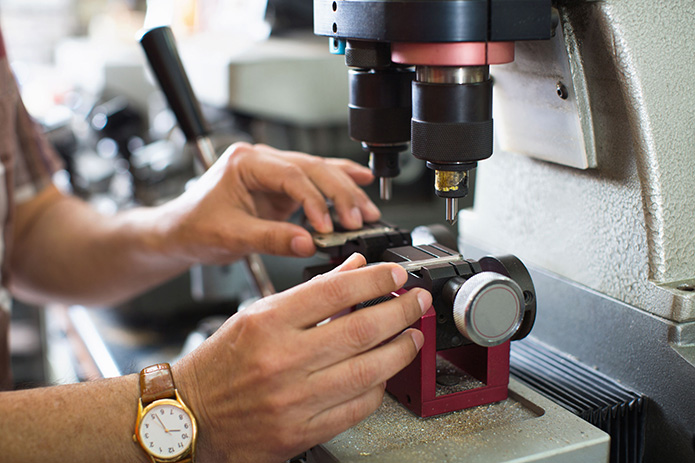A locksmith is typically not on our minds until we get locked out of our house, car or business, right? In fact, it’s a service that most of us take for granted. But did you ever wonder what life was like before this trade was established?
Locksmiths today offer services that span an array of services from re-keying to camera systems.
The history of the locksmith is an evolution worth knowing about and since its inevitable that you will probably need to call one at some point in your life, you’ll have an appreciation for their service.
Ancient Locksmiths
Archeologists discovered that the history of locksmiths goes back at least 4,000 years. They discovered the oldest known lock in Egypt. Interestingly, this primitive lock was similar to the pin tumbler locks we use today, though made of wood. The lock worked by securing the door with a large bolt. The bolt had several holes on its top, which were filled with pegs that prevented the bolt from moving.
This concept of the warded lock became a mainstay of the ancient world, its use being recognized all over Europe and the Western world. In decadent ancient Rome, the rich kept their valuables in secure boxes and wore the keys on their fingers, a symbol of their status. Gradually, as metallurgy became more sophisticated, blacksmiths began to construct locks using metal and wooden components. Historians estimate that the first all-metal locks arose from England between 870 and 900.
Metals in Locksmithing
Blacksmiths continued to serve as locksmiths until the industrial revolution created more complex locks requiring increased specialization. As a result, professional locksmiths as we know them came into being. Pre-industrial revolution locksmithing was a laborious and time-consuming affair, with the smith creating all the intricate pieces by hand. This process required extensive shaving of the metal and hand cutting of the screws. The cost was also very high because of the labor involved, which limited production and made sophisticated locks more of a luxury than a necessity.
A good blacksmith could make padlocks and simple rim locks. These require just basic metal working skills. More complex locks required understanding lathe turning, spring tempering, rivet and screw making, precise fitting and hole punching. Pre-industrial locksmithing also required the ability to design the lock.
The locksmiths of old designed their locks with two goals: making them attractive and complex. Locks were placed on outer doors, so customers were concerned with appearance. Most were made with attractive rectangular designs out of sheet iron. Wealthy customers often ordered brass locks.
Deterring the Thief
To defeat lock pickers, locksmiths depended on an unbreakable arrangement of the wards within the lock case. These are circular fins in the keyhole that the key must match. Though this security system certainly kept out casual intruders, experienced lock pickers could defeat them by inserting a dummy key covered with wax. The wax impression would give the criminal all the information needed to manufacture a copy by filing the correct pattern into the dummy key.
Thieves also circumvented locks with skeleton keys. These keys had an unusually narrow bit that would miss the wards and engage the lockbolt. They were unusually long so they could work on most locks.
Locksmiths and Transparency
In the late 1800s, a great debate ensued regarding “full disclosure”. Full disclosure required locksmiths to be upfront about the weaknesses inherent in locks. Many people believed that locks made their property completely secure; however, locksmiths understood the methods thieves could use to defeat them. Those whom believed in full disclosure, such as famous locksmith A.C. Hobbs, argued that the thieves were already completely aware of how to pick locks. He reasoned that keeping this a secret from the public only helped the thieves because it gave people a false sense of security. By making the public aware of the flaws in locks, full disclosure motivated people to be vigilant about crime prevention.
Mass production brought locks to the common people and eventually made them ubiquitous around the world. It also changed the job of locksmithing. The days of designing locks and hand crafting them were gone forever. Despite this, the locksmithing profession has seen continued growth.
The Modern Locksmith’s Changing Role
Today’s locksmiths primarily provide lockout service, install new locks and provide recommendations for the best type of locks for particular locations. In addition, locksmiths enhance security by shoring up elements of the door and door frame. A good locksmith is a security consultant as well as a technician. Locksmiths understand how to defeat locks, which is part of their job. As experts in breaking locks, they are also experts in protecting against vulnerabilities.
Locksmithing has been an essential trade for millennia. People always have property to protect but cannot watch it all the time. From ancient Egypt to the modern day, locksmiths have worked to foil bandits in a never-ending game of innovation. As thieves think of new ways to defeat locks, locksmiths must always be adding new security features that make breaking the lock too difficult for the criminals to bother.
Action Locksmith serves the Michigan Tri-County area and beyond. We are a mobile locksmith service that does it all and are available 24 hours a day 7 days a week. If you have an emergency, we’ll be there. Our locksmiths are professional and trained in residential, automotive, and commercial locksmith services. We can also help you with your home or business safe. Our vast experience and knowledge have made us a trusted and respected Michigan business. Call us to learn more about how we can help!

